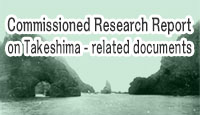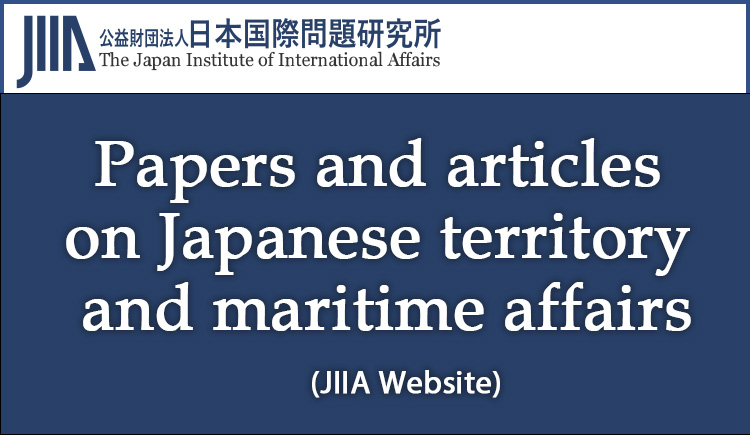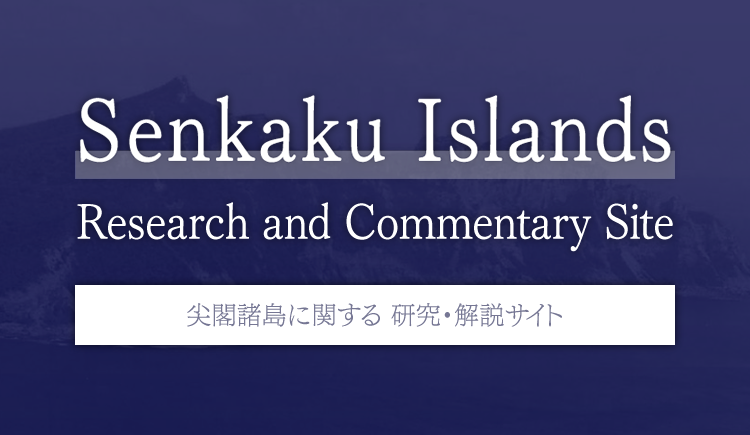The documents and materials published on this website were collected, researched, and prepared with advice from experts, as a part of a Government-commissioned project. The contents of this website do not reflect the views of the Government.
Comprehensive issues
3. Evaluation under international law
(1) Legal nature of the 1905 Cabinet decision
The Japanese government’s position is that “Japan had established sovereignty over Takeshima by the mid-17th century (early Edo period) at the latest.”16 So why did Japan “reaffirm its sovereignty” over Takeshima through a Cabinet decision, if its sovereignty had already been established? The reason was that historical titles17 that had previously been recognized through common understanding since ancient times needed to be “substituted”18 or “replaced”19 with titles as required by modern international law.
In the East Asian world order to which Japan belonged, there was no concept that would equate to that of “territory,” which formed the basis for the European international order. The basis for the East Asian world order was the “domain.”20 That is why, when Japan came to accept and apply modern international law of European origin based on the concept of “territory,” it became necessary to “substitute” or “replace” historical titles that were considered to have been held in “domains” with “territorial titles.”21
The necessity for such “reaffirmation” has also been pointed out in international courts. In the Minquiers and Ecrehos case, the International Court of Justice noted that even if the kings of France did have an original feudal title to the islets in dispute, such an alleged original feudal title could today produce no legal effect, unless it had been replaced by another title valid according to the law of the time of replacement.22 This is because the court was of the opinion that, “What is of decisive importance, is not indirect presumptions deduced from events in the middle ages, but the evidence which relates directly to the possession” of the islets in dispute.23 An arbitral tribunal in a dispute between Eritrea and Yemen made similar observations. 24
The Minquiers and Ecrehos case was between the United Kingdom and France, both part of the European international order, while the Eritrea-Yemen arbitral tribunal case was one between countries adhering to the Islamic international legal system, and both of these cases had origins in legal systems that were wholly different to the modern international legal system. Accordingly, the opinions expressed in these court judgments are also valid when making the transition from the East Asian world order to the traditional international legal order.25 In short, modern international law does not prohibit countries that belonged to the East Asian world order from taking “reaffirmation” or similar measures in order to strengthen claim to or put beyond doubt any historical titles that had already been established in the process of accepting modern international law and being incorporated into the European international order.26 It is rather the case that modern international law required to clearly express intent to claim sovereignty, to “substitute” or “replace” the title in effect at the time, and to exercise effective control, with just such a method.
(2) Method of expression of intent to claim
The notice issued by Shimane Prefecture was not issued “in a secretive manner,” and the contents of the notice were known to “normal Japanese citizens.” This is because, as noted above, the notice was issued throughout Shimane Prefecture and also reported in the newspapers of the day (see Section 1 above).Next, it is indeed a fact that it was a “notice by a single provincial government” and that “the government of Korea at the time was not notified through official diplomatic procedures.” However, with regard to the former, under international law, there is no fixed format for expressing territorial intentions. It is not even necessary to do so explicitly, since the intent to claim can be presumed if state functions are peacefully and continuously displayed on the territory in question.27 In any event, the method of notification through the offices of local government was commonplace at the time,28 and the attribution of Takeshima is clearly indicated by a national institution, constituting an appropriate expression of the intent to claim.
Furthermore, with regard to the latter point, there is no obligation to notify foreign governments of the intent to claim unless there is an explicit legal stipulation that requires otherwise.29 An example of such a legal stipulation is the General Act of the Conference of Berlin of 1885. Article 34 of this act stipulates that a condition of occupation is that “the Power shall accompany the respective act with a notification thereof.” However, the effect of this act was limited to the coastal regions of Africa30 and does not apply to East Asia. An eminent scholar of international law once predicted “there is no doubt that in time this rule will either by custom or by treaty be extended from occupations in Africa to occupations everywhere else.”31 His prediction proved not to be the case and international law did not develop in the way that he had anticipated.32
Note 16
Ministry of Foreign Affairs of Japan, 10 Points to Understand the Takeshima Dispute, (Point 3: Japan had established sovereignty over Takeshima by the mid-17th century at the latest), p. 8. Available to download here.
Ministry of Foreign Affairs of Japan, “Japanese Territory: Sovereignty over Takeshima; 4,” available to view here.
Note 17
Matsui Yoshiro, International Law Perspective on the Senkaku Islands Dispute, (Nihon Hyoronsha, 2014), p. 50 *1.
Note 18
Minagawa Takeshi, “The Takeshima Dispute and International Judicial Judgments,” in Prof. Mitsuo Maehara 60th Birthday Commemoration Anthology Committee ed., Various Issues in International Law (Prof. Mitsuo Maehara 60th Birthday Commemoration), (Keio Tsushin, 1963), p. 363.
Note 19
Taijudo Kanae, “The Takeshima Dispute,” (first published 1986), in International Law of Territorial Sovereignty, (Toshindo, 1998), p. 143.
Note 20
Matsui, supra note 17, p. 115. The “domain” was a concept that was valid in the “’international’ normative order of East Asia.” Park Pae-Keun, “Precedent Cases of Occupation of Islands by Japan: Focusing on Territorial Claims on Takeshima/Dokdo,” The Journal of International Law and Diplomacy, Vol. 105, No. 2 (2006), pp. 32-33.
Note 21
Matsui, op. cit. (supra note 17), p. 118.
Note 22
The Minquiers and Ecrehos case, Judgment of November 17th, 1953: I.C.J. Reports 1953, p. 56.
Note 23
Ibid., p. 57. See also, Sahara occidental, avis consultative, C.I.J. Recueil 1975, p. 43, para. 93.
Note 24
Award of the Arbitral Tribunal in the first stage of the proceedings between Eritrea and Yemen (Territorial Sovereignty and Scope of the Dispute), Decision of 9 October 1998, Reports of International Arbitral Awards, Volume, XXII, p. 245, para. 131, p. 268, para. 239.
4. Conclusion
The above considerations clearly demonstrate that there is absolutely no basis in international law for the assertions made by the ROK government. Accordingly, as the Japanese government explains, the series of incorporation measures that were taken following the Cabinet decision were in accordance with international law of the day, and this “does not indicate or imply that prior to [the Cabinet decision] Japan did not hold sovereignty over Takeshima, or that sovereignty was held by some other State,” and the measures were “also published in the newspapers of the day, and were implemented effectively, without any recourse to clandestine measures.”
A final point should be made concerning the assertions of the ROK government that, “In any event, the stipulations of Imperial Edict No. 41, which was issued in 1900, ‘“clearly demonstrates the fact that…[Korea] had continued to govern Dokdo and exercised Korea’s sovereignty over Dokdo.”.’ What is more, the measures by Japan to incorporate the islands, “was not only an illegal act that infringed upon Korea’s long-standing and undeniable sovereignty over the island, but also null and void under international law.”” (See Section 1 above). Imperial Edict 41 was issued for the purpose of changing the name of Utsuryo Island (Ulleungdo) to Utsu Island (Uldo), and to promote the island administrator to county magistrate. The ROK government asserts that Article 2 of the edict clearly states that “all of Ulleungdo as well as Jukdo and Seokdo (Dokdo)” shall be placed under the jurisdiction of Uldo county.33 However, given that in the original document there is no mention of “(Dokdo),” this raises the question, if “Seokdo” was today’s Takeshima (“Dokdo”), why did the Imperial Edict not use the name “Dokdo” and instead use “Seokdo” as the name of the island?34 Even if such doubts could be overlooked and it was established that Seokdo refers to Takeshima, there is no evidence of effective control of Takeshima by the Korean Empire before or after the promulgation of the edict, so it cannot be stated that territorial rights by Korea had been established. Even in a hypothetical scenario in which the ROK possessed some kind of historical title to Takeshima, this was not substituted for a title based on effective control. In contrast, “The incorporation of Takeshima in 1905 by the Japanese government, and the subsequent continued manifestation of state functions there served to adequately replace Japan’s title, which is thought to have been validly established in the 17th century, and largely in conformity with international law of the time, and make it compliant with contemporary demands.”35 Accordingly, the incorporation measures could in no way be described as “an illegal act that infringed upon Korea’s sovereignty.” They were measures with international legal effect that were conducted in strict accordance with the rules of modern international law.
Note 25
Matsui, supra note 17, p. 124.
Note 26
Park, supra note 20, p. 38.
Note 27
Taijudo, supra note 19, p. 144.
Note 28
“View of the Government of Japan in Response to the View of the Government of the ROK Concerning Takeshima dated September 25, 1954,” (September 20, 1956), Tsukamoto, The Reference supra note 7, p. 62.
Note 29
Island of Palmas Case (Netherlands/United States of America), Award of 4 April 1928, Reports of International Arbitral Awards, Vol. II, p. 868.
Note 30
Affaire de l’île de Clipperton (Mexique contre France), 28 janvier 1931, Reports of International Arbitral Awards, Vol. II, p. 1110.
Note 31
L. Oppenheim, International Law: A Treatise, 1905, §224., pp. 278-279.
Note 32
M. F. Lindley, The Acquisition and Government of Backward Territory in International Law, 1926, p. 295.
Note 33
Ministry of Foreign Affairs of the ROK, supra note 9, p. 9.
Note 34
Ministry of Foreign Affairs of Japan, op. cit. (supra note 16), (“Q4: Prior to the Japanese government’s incorporation of Takeshima in 1905, is there any proof that Korea owned the islands?”) p. 24. Available to download here.
Also see, Ministry of Foreign Affairs of Japan, “Japanese Territory: Incorporation of Takeshima into Shimane Prefecture; 6,” available to view here.
Note 35
Taijudo, supra note 19, p. 143.
Takeshima
Research and Commentary Site
- I Comprehensive issues
- II Commentary on themes by historical period
- III Analysis of claims by other countries





